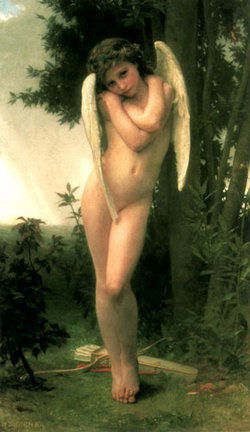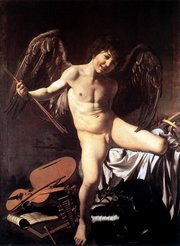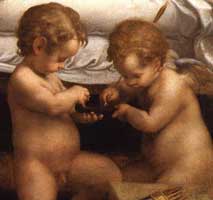.

Cupidon (French for Cupid), by William-Adolphe Bouguereau, 1875
In Roman mythology, Cupid was the god of erotic love.
Cupid's lineage
There are differing stories about his parentage. Cicero provides three different lineages: son of Mercury (Hermes) and Diana (Artemis), son of Mercury and Venus (Aphrodite), and son of Mars (Ares) and Venus. Plato mentions two of these, and Hesiod's Theogony, the most ancient Greek theoography, says that Cupid was created coevally with Chaos and the earth.
Throughout ancient mythological writing, there appear to be either two Cupids or two sides to the figure of Cupid. One is the son of Jupiter (Zeus) and Venus. He is a lively youth who delights in pranks and spreading love. The other is a son of Nyx and Erebus, and he is known for riotous debauchery.
Cult
Cupid's cult was closely associated with Venus', and he was worshipped as seriously as she. Additionally, his power was supposed even greater than his mother's, since he had dominion over the dead in Hades, the creatures of the sea, and the gods in Olympus. Some of the cults of Cupid suggested that Cupid (as son of Night and Hell, perhaps) mated with Chaos to produce men and gods alike, so the gods were the offspring of love.
Portrayal in art and literature

Caravaggio's Amor Vincit Omnia
In painting and sculpture, Cupid is portrayed as a winged infant armed with a bow and a quiver of arrows. He is often mistaken for the Christian depiction of a cherub. On gems and other surviving pieces, he is usually shown amusing himself with childhood play, sometimes driving a hoop, throwing darts, catching a butterfly, or flirting with a nymph. He is often depicted with his mother (in graphic arts, this is nearly always Venus), playing a horn. He is also shown wearing a helmet and carrying a buckler (perhaps in reference to Ovid's "amor vinces omnia" or as political satire on wars for love or love as war).
Cupid figures prominently in ariel poetry, lyrics, and, of course, Ovid's love and metamorphic poetry. In epic poetry, he is less often invoked, but he does appear in Virgil's Aeneid changed into the shape of Ascanius inspiring Dido's love. In later literature, Cupid is frequently invoked as fickle, playful, and perverse. He is often depicted as carrying two sets of arrows: one set gold-headed, which inspire love, and the other lead-headed, which inspire hatred.
The most well-known story involving Cupid is the tale of Cupid and Psyche, first attested in Apuleius' picaresque novel, The Golden Ass, written in the second century AD.

See also
| Ancient Greece
Science, Technology , Medicine , Warfare, , Biographies , Life , Cities/Places/Maps , Arts , Literature , Philosophy ,Olympics, Mythology , History , Images Medieval Greece / Byzantine Empire Science, Technology, Arts, , Warfare , Literature, Biographies, Icons, History Modern Greece Cities, Islands, Regions, Fauna/Flora ,Biographies , History , Warfare, Science/Technology, Literature, Music , Arts , Film/Actors , Sport , Fashion --- |
Retrieved from "http://en.wikipedia.org"
All text is available under the terms of the GNU Free Documentation License

